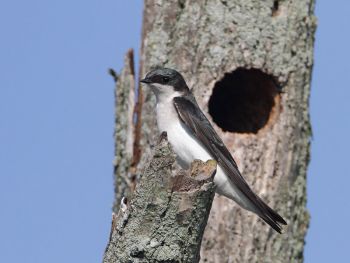- Tachycineta bicolor
Identification

Photo © by bobsofpa
Middle Creek Wildlife Management Area, Lancaster County, Pennsylvania, USA,
26 April 2011
L. 5-6 1/4 in (13-16 cm)
- Sparrow-sized
- Metallic blue or blue-green above
- Clear white below
Juveniles are dull brown above.
Similar Species
Young birds can be distinguished from Bank Swallow and Northern Rough-winged Swallow by their clearer white underparts.
Distribution

Photo © by Stanley Jones
Anahuac National Wildlife Refuge, Chambers County, Texas, USA, March 2018
Breeds from Alaska east through northern Manitoba to Newfoundland and south to California, Colorado, Nebraska, and Maryland.
Northern limit to wintering range stretch from southern California to the Gulf Coast and the Carolinas; occasionally farther north along the east coast.
The main wintering range is from Florida along the Caribbean coast of Central and South America to north-west Venezuela.
Accidental vagrant to the UK and eastern Siberia.
Taxonomy
This is a monotypic species[1].
Habitat
Lake shores, flooded meadows, marshes, and streams, creeks.
Behaviour
It is the first of our swallows to reappear in the spring.
Tree Swallows often enjoy playing with a feather, which they drop and then retrieve as it floats in the air.
They gather in enormous flocks along the coast in fall, where they circle.
Breeding

Photo © by Stanley Jones
Brazos Bend State Park, Fort Bend County, Texas, USA, 20 April 2021
Hole-nesters such as the Tree Swallow often face a housing shortage and must fight to get into, or keep, woodpecker holes or other sought-after nest sites. Man-made breeding boxes may help increase the numbers of these birds. The Tree Swallow almost invariably nests in the immediate vicinity of water. 4-6 white eggs in a feather-lined cup of grass placed in a hole in a tree or in a nest box
Diet
Insects caught on the wing. During winter, also feeds on berries.
This bird's habit of feeding on bayberries enables it to winter farther north than other swallows.
Vocalisation
Cheerful series of liquid twitters.
References
- Clements, J. F., T. S. Schulenberg, M. J. Iliff, S. M. Billerman, T. A. Fredericks, B. L. Sullivan, and C. L. Wood. 2019. The eBird/Clements Checklist of Birds of the World: v2019. Downloaded from http://www.birds.cornell.edu/clementschecklist/download/
Recommended Citation
- BirdForum Opus contributors. (2024) Tree Swallow. In: BirdForum, the forum for wild birds and birding. Retrieved 23 April 2024 from https://www.birdforum.net/opus/Tree_Swallow
External Links
Search the Gallery using the scientific name:
Search the Gallery using the scientific name:
GSearch checked for 2020 platform.






